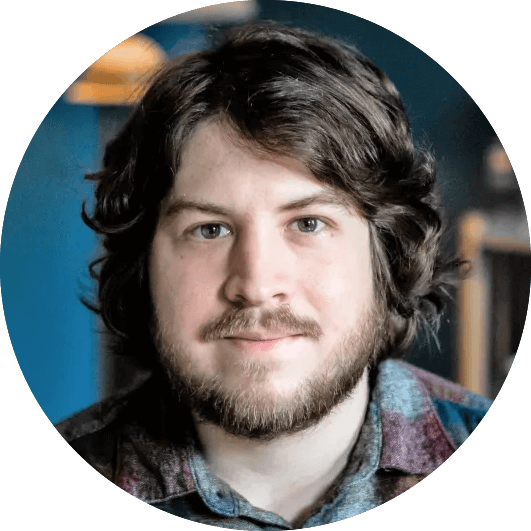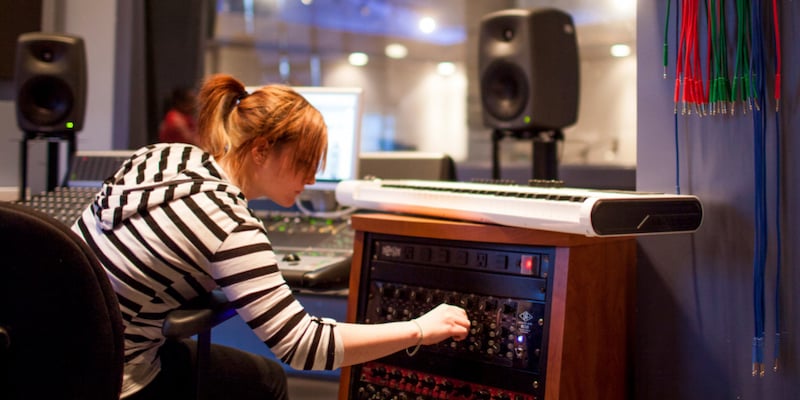How to learn fundamental skills, improve at your craft, and set yourself up for success in the audio post industry.
Whether your dream job is to design sound effects for blockbuster films, be a one-person sound department for independent projects, or edit dialogue and music for podcasts, you’ve got to start somewhere.
There are many paths through the post-production sound industry, and where you start may not necessarily dictate where you end up. But in the early stages of your career, there are a few key steps that everyone needs to take, such as learning fundamental skills, practicing them, and building up a portfolio of work. Read on to learn what you need to do to start your career off on the right foot.
Learn, Practice, Repeat
In the beginning stages of your audio post career, it's best to focus on learning fundamental skills and practicing them in a low-stakes environment. While the urge to start looking for work right away can be strong, you’ll benefit immensely from taking some time to research the profession, ask “stupid” questions, and make mistakes.
During this period, you’ll most likely be relying on another job for income, meaning you’ll have to do your learning and practicing in your free time. This is the first test – if you find that you enjoy working with sound enough to do it unpaid on your own time, you’re already on your way to a career.
Learning the Fundamentals
When it comes to learning the basics of post-production audio, seek out the medium that you learn best from. If you absorb information best by watching videos, YouTube is full of tutorials on sound design, session organization, field recording, freelancing, and interviews with acclaimed sound artists. If you prefer to listen, podcasts such as Tonebenders and The SoundGirls Podcast are another great way to learn.
If you learn best by reading at your own pace, you’re already in the right place. After reading this article, be sure to check out our 101 Series articles, “Behind the Sound” interviews, and how-to guides. Finally, if you require interactive instruction to flourish, consider enrolling in an accredited sound design program at a school like SCAD. Whichever way you choose to learn, there’s no shortage of knowledge out there to absorb.
Practicing Your Skills
While you’re still learning and not yet under pressure to pay your bills with audio work, you’re free to practice on your own terms – without worrying about client expectations, delivery specs, and revisions. By practicing concurrently with your studies, you’ll have a chance to apply your new knowledge while it’s fresh in your mind, and the fundamentals of audio will become second nature in no time.
One great way to practice a range of different skills in small steps is to give yourself a daily sound design challenge for a week or month. Give yourself a list of prompts such as “car chase,” “rainforest ambience,” “medieval knight Foley,” and so on, then complete one each day. You’ll learn something new with each mini-project without getting bogged down in trying to do everything perfectly.
When you’re ready to combine some of those skills and techniques, try redoing the sound for a short clip from an existing movie, show, or game (often called a “redesign”). Choose a 30 to 60-second section without dialogue or music and add your own backgrounds, Foley, and spot effects until you’ve fleshed out the entire scene. You’ll quickly learn what works and what doesn’t, which will give you a leg up when you start working on real projects.
"In the beginning stages of your audio post career, it's best to focus on learning fundamental skills and practicing them in a low-stakes environment."
Your sound library will be one of your most important assets, so start building it now!
Equip Yourself for Success
In order to work with sound, you’ll need a few key tools including software, sound libraries, and plugins (for the sake of this article, we’ll assume that you already have a set of headphones or monitors). However, until you’re making money from your craft, there’s no sense in investing a lot of capital. Build your toolkit slowly, starting with free and inexpensive software, then purchase advanced tools only when you can justify the cost.
Choosing a DAW
The first thing you’ll need is a Digital Audio Workstation (DAW) software. If you don’t already have one, we recommend picking a DAW that has robust features and is popular enough to have support and community resources, such as Nuendo, Pro Tools, Logic Pro, or Reaper. But don’t just pick one because you’ve seen others use it – evaluate your choice based on the features that matter to you.
Fortunately, each of the DAWs listed above has an accessible entry point: Steinberg offers a 60-day free trial of Nuendo while Avid offers Pro Tools Intro for free, as well as a 30-day trial of the full software. While Logic Pro is only available on Apple products, there is a generous 90-day free trial. The best deal of all, Reaper offers a fully-featured trial with no paywall – only the expectation that you support the company with a $60 discounted license or $225 commercial license.
Building Your Sound Library
If you want to be a sound editor (as opposed to a mixer, dialogue editor, or music editor), it’s important to start building your sound library right away. Our SoundQ software offers both free and subscription plans, giving you access to a comprehensive search engine full of world-class, ropyalty-free sound effects and music. If you prefer to buy sound effects outright, our CORE bundles are available in several tiers to give your collection a jumpstart.
It’s also a good idea to start building up your personal library by recording your own Foley and sound effects, interesting raw material for sound design, and field recordings for background ambience. Handheld recorders with built-in microphones are an inexpensive starting point, and you can always upgrade your kit later. The more of your own recordings you have, the more unique your collection will be. Plus, you’ll gain valuable recording experience that will come in handy later.
Plugins and Other Tools
No matter which aspect of audio post you want to specialize in, you’ll need a variety of tools. Fortunately, all of the DAWs mentioned above come with a fairly robust set of editing functions and stock plugins including EQ, compression, reverb, delay, and so on. These will be your go-to tools in the early stages of your career, so learn to get the most out of them.
Depending on your needs, you may need a few specialized tools as well. For example, sound effects editors and sound designers usually prioritize plugins for creative processing such as distortion, harmonizers, and doppler effects. On the other hand, dialogue editors get more use out of things like noise reduction, audio restoration, and phase-alignment, while mixers favor mixing-specific tools like convolution reverb, multiband compression, and dynamic EQ.
Start Getting Credits
Your experience is probably the most critical factor in getting hired, so it’s important to start accumulating credits as early as possible. Your first few credits will likely be on small-scale projects such as short films, YouTube videos, animation projects, and the like. And that’s a good thing – these projects move quickly, so you can get experience and move onto the next project with new ideas and techniques. And, if one or two don’t turn out as well as you’d like, the stakes are low enough that it won’t damage your prospects.
How to Get Experience
There are many places to get these first few gigs: friends, family, and classmates can all be sources of introductory work before you officially put yourself on the market. Volunteering your skills is another great way to gain early experience. See if your local film festival organization, city or state film commission, or nearby schools have a grant program you can donate work to in exchange for experience and credit.
Even if you already have a clear vision of the kind of work you want to do, don’t be afraid to try different types of projects. For example, podcasts can help you hone your dialogue editing skills, while making sound effects for a mobile game is a great way to practice concise and impactful sound design.
Work Smart and Value Your Time
At this stage of your career, it’s best to build up a small list of credits fast, so try to avoid getting bogged down in projects which balloon in scope or drag on longer than you signed up for. Be clear and up-front about how much time you can commit and ask your collaborators for specific project timelines and goals. If they can’t commit to at least a rough schedule, it might be better to pass on that particular opportunity and find a more serious collaborator.
Finally, always make sure you’re compensated for your work in some way (with the exception of volunteering). Without much work under your belt, it can be tricky to estimate the time you’ll end up putting into these projects, so just do your best to set rates that earn as much as your day job, or at least more than minimum wage. Alternatively, you can barter your skills in a labor trade, such as having an animator make a logo for your business or a filmmaker take pictures of you and your studio for your website.
Once you’ve built up a small list of credits, you can use that portfolio to get the next gig, and the next, and so on; moving up to more serious projects with bigger budgets as you go.
"Even if you already have a clear vision of the kind of work you want to do, don’t be afraid to try different types of projects. For example, podcasts can help you hone your dialogue editing skills, while making sound effects for a mobile game is a great way to practice concise and impactful sound design."
Sound design programs at schools like SCAD are just one of many valid paths into the industry.
Find Your Path
Once you have an intermediate level of skill and a few projects in your growing portfolio, you’ll have to pick a direction for your next step. Do you see yourself working closely with independent filmmakers? Joining a small production house or ad agency? Getting your foot in the door with a major Hollywood studio and working your way up the ladder? Each of these roles require different skill sets, which is why it’s important to pick a direction to specialize in.
Take some time to evaluate what matters to you when it comes to your career, including the kind of work you want to do, the environment you work best in, and what you want to be doing in five to 10 years. Then, think about what you need to do to get there – what kind of connections would you need to make? How much experience do you need under your belt, and what kind? Which skills do you still need to learn or improve?
The Indie World
If you enjoy the flexibility, creative freedom, and close collaboration of working with independent filmmakers, your next step should be to get your business affairs in order. Choose a business structure (such as an LLC in the U.S.) and register your business, then open a separate business account with your bank. You’ll also need to learn how to invoice your clients, keep track of your income and expenses, and pay quarterly estimated taxes. Getting organized will not only save you a ton of headaches, it will make you look far more professional to your clients.
Small Studios and Corporate Jobs
If you like the idea of working in a more organized environment and don’t mind sacrificing some creative control, your next move should be to update your resume and start looking for jobs in your area or remotely. There’s a wide range of jobs at this tier, from sound design for advertising to podcast editing for universities and social media content for corporations. Depending on the state of the job market, you may need to freelance for a while before you’re able to land an in-house job.
The Big Leagues
Finally, if your dream is to work with a large team on big-budget features, you’ll need to find some way to get your foot in the door. Many people choose to jump in head-first by moving to major film hubs like Los Angeles and New York, where they start as low-level interns or runners and work hard to climb the latter. Others leverage connections from former classmates, instructors, and clients to land jobs assisting sound supervisors, who sometimes turn into long-term collaborators. If you choose this path, keep in mind that it's extremely competitive – it’s not enough to be good at what you do; there’s also a lot of sacrifice and plain old luck involved.
Find Your Path
Whichever route you choose, there’s one thing that never changes: you have to meet people and make connections. And no, we don’t mean shallow networking and trading business cards – we mean genuinely getting to know people in the industry. Talk to other up-and-coming people in your field at meetup events and online. Compliment a filmmaker on their work without immediately talking about collaborating. Send a follow-up to thank a job you didn’t land for considering you.
Think of each of these interactions as a seed that could someday sprout into a job. Plant as many seeds as you can, but don’t just scatter them to the wind – plant each one with care and follow up once in a while to keep the relationship growing. You never know where it might lead!
As your career begins to grow, keep a learning mindset and never stop seeking out new sounds, and learning new techniques and technologies, and finding better ways to do things. As long as you’re proactive about continuing your education, you’ll never feel like you’ve hit a wall or plateaued in your career.
Finally, be sure to keep up with the Pro Sound Effects blog and follow us on social media for the latest articles, interviews, tutorials, and more!
Dante Fumo is a Midwest-based sound designer, editor, and mixer specializing in independent film and Dolby Atmos mixing. In his free time, Dante composes electronic music and publishes Harmonic Content, a zine about sound.















